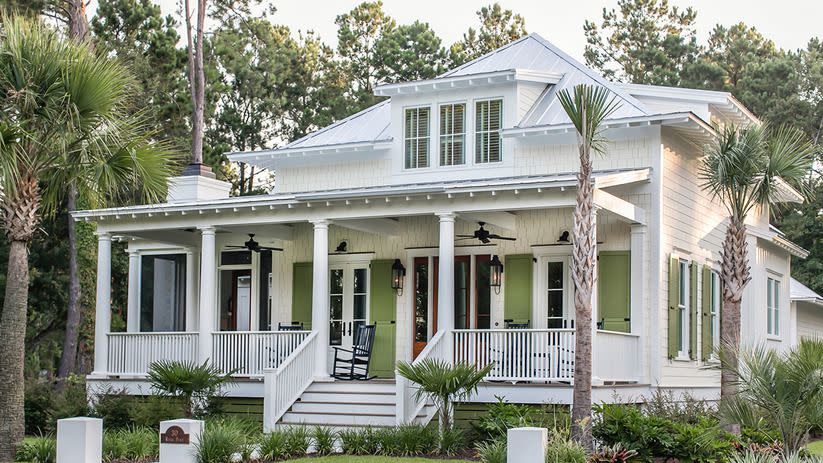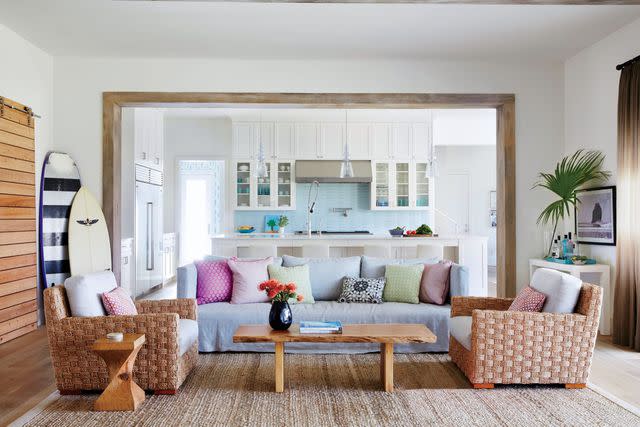Designing A Vacation Home? Here's What To Do (And What Not To Do), According To The Pros
Design your vacation home like a pro with these tips from the experts.

Designing a vacation home may feel like a daunting undertaking, but the process should be enjoyable and full of excitement, too! If you’re wondering what tasks to prioritize—as well as what to avoid—during this endeavor, keep reading for insight from pro designers. Below, they map out how to design the vacation property of your dreams like a total expert.
Gather Your Inspo First
As is the case with any design project, you’ll need to make a plan and determine how you would like a space to look and feel before you begin making any purchases. “Browse through magazines, coffee table books and social media sites to collect images that resonate,” suggests interior designer Katharine Rhudy, the owner of Reed & Acanthus in New Orleans. While brainstorming, keep the location of your vacation property top of mind, too, of course. “Consider surrounding architecture and look for inspiration from local furniture showrooms, art galleries or hotels,” Rhudy suggests.
Don’t Be Too Literal
While you’ll want to play to your home’s location during the design process, you don’t need to do so in an ultra literal manner. “Pay subtle respects to the surroundings without going overboard and becoming too thematic,” comments Lauren Sullivan, the founder of Well x Design in Kingsport, Tennessee. “You don’t have to have a seashell lamp at a beach house—instead focus on creating a cohesive, relaxing color palette and layering materials such as linen, rattan, and jute with antique or found objects,” she suggests.

Think About How You’ll Use Your Space
You may be planning to use your vacation home for different purposes than you would a primary residence. Overall, Rhudy says, “Vacation homes are viewed as places which to escape, relax, and entertain.” This means that open floor plans and outdoor spaces are often key. If you’ll often be hosting large groups of friends and family, Rhudy recommends keeping entertaining areas such as the dining room and great room top of mind, but if the home will primarily be just for your immediate family to enjoy, focus instead on the living room and kitchen.
If you’ll be renting your home out to Airbnb guests when your family isn’t using the space, this will impact your design decisions, too. “Luckily, there is quite a bit of overlap between creating a durable vacation home for a young family and a hard-wearing vacation rental,” says Bethany Adams of Bethany Adams Interiors, who plans to rent out her own space. It all comes down to making thoughtful decisions on how to maximize space. “When we’re in residence, the guest room will serve as our shared home office, but when it's a rental a king-sized Murphy bed and adjoining powder room will maximize the amount of guests we can host—and the profit we can make,” the Louisville-based designer explains. “The two kids rooms will each have a set of bunk beds—great for my girls when they want to have a friend sleep over, but also fantastic for an Airbnb, as we'd be able to host two families, or one large one, at a time.”
Don’t Forget To Tackle The Entryway And Make It Accessible
The entryway is a key component of any vacation home. “Both warm and cold weather destinations require some serious messy gear, and having a space to shake off that sand, snow or dirt and store that gear is super helpful in maintaining the rest of the home,” explains Erin Stezer, owner, president, and project executive of Stetzer Builders in Houston. “It’s also way more enjoyable for that mess to be tucked away, so you don’t have to see it!” On a related note, making sure that accessibility is top of mind is also essential. “You never know who will be in need of accessibility in the home at some point,” Stezer says. “So, first floor bedrooms, wide doorways, and ramp access to the first floor are important.”
Keep Guests’ Comfort In Mind
Even if you don’t plan to host guests at your vacation home every weekend, you will likely have company at some point throughout the year and will want to design your space accordingly. “Flexible seating and sleeping areas are a must,” Rhudy shares. “Sofa beds, bunk rooms, and even blowup mattresses are handy for overflow.”
Catherine Brooks Giuffre of CBG Interiors in Houston offers some guidance for furniture shopping. “Chaises, low chairs with deep pitches and ottomans, porch swings, pillows and throws on every piece of furniture lend the perfect ‘nap spot,’” she notes. “The point of a vacation is to rest and relax, even if you’re hosting and entertaining! Comfortable pieces offer an excuse to recline.”
You won’t want to worry about spills and stains, either. Rhudy advises opting for high performance, stain resistant fabrics on all upholstered pieces. Skip the carpeting, too. “Wood or laminate flooring is easier to maintain and clean when the house is occupied by families with children and pets,” the designer adds.

Don’t Solely Purchase New Items
There’s no need to buy all brand new items for a second home. Why not go the vintage route or repurpose some of your existing pieces instead? “Use a clever mix of antiques and contemporary furniture,” suggests Lucinda Loya of Lucinda Loya Interiors in Houston. “Well-traveled accumulated heirlooms and pieces from different periods that feel collected achieve a timeless design that never goes out of style.” Take a look around your primary home and see if there are any unused pieces that may shine in your vacation home. Loya adds, “Give them a new life in a fresh space—a fresh coat of paint can work wonders!”
Include An Office If You Wish
The concept of designing a workspace within a vacation home may have previously seemed counterintuitive, but today, many employees maintain remote schedules and may need to log into meetings from time to time while traveling. Don’t be afraid to incorporate an office into your floor plan. “This is a perfect place for a pull out sofa and a wall with built-ins containing cabinets and a desk,” Rhudy says.
Think Outside The Box
One excellent aspect of designing a vacation home is that you may feel more comfortable making choices that are a bit outside of the box. “Experiment and have fun,” Rhudy urges. “A vacation home is the place to try something you may feel hesitant about doing in your main residence.” There is no right or wrong way to go about this, either. “Try creating a feature wall with a bold color or funky wallpaper, go big with art or wall sculpture, mix in an antique or vintage piece of furniture or add unique, artistic lighting,” she suggests. “Personal touches that reflect your tastes and interests are what make a vacation home feel special.”
For more Southern Living news, make sure to sign up for our newsletter!
Read the original article on Southern Living.

